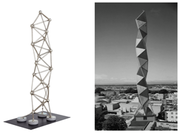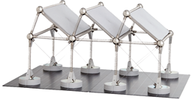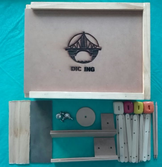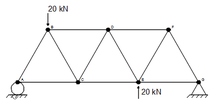1. Introduction
From a wide perspective, for centuries engineering education has been based on French, English and Spanish teaching models [1]. The French model emphasizes previous training in basic and engineering sciences, aimed at developing abstract rational thinking skills, while the English model is based on practical competences as a complement of theoretical development. Walczak et al. [2] suggest that significant improvements in teaching methods are required to transform the role of apprenticeship students, from passive recipients of information to active participants in the acquisition of knowledge.
Particularly for civil engineering programs, in recent decades there have been new challenges and opportunities [3], as a result of the incorporation of new content, methodologies and teaching techniques [4]–[6].
In civil engineering undergraduate programs, traditional teaching has been predominant for years, where knowledge is measured through tests based on arbitrary contexts, which are generally not related to future work contexts. Consequently, students finish many of their undergraduate courses having only theoretical knowledge about concepts, but without knowing how to apply them to reality [7]. In this sense, several researches have tried to consider this situation. For example, Ebner and Holzinger [8] point out that the use of online games could be important in the creation of motivating environments, facilitating that complex theoretical knowledge is more accessible, as long as it is accurate to capture the audience’s attention. In fact, one of their results suggests that the learning of a group of students who learned through online games was equivalent to that group that learned through the traditional method, but the first group enjoyed more this type of learning. In conclusion, they point out that this methodology, based on online games, can be useful when teaching future civil engineers [9]–[12].
On the other hand, the track for a student to obtain the professional degree of civil engineer requires passing science courses: basic, engineering and application [7], where Statics —course considered within the basic sciences for civil engineering programs—, studies the behavior of the structures when they are subjected to external loads, being the base and fundamental pillar for all the areas of civil engineering.
1.1. Problem to analyze
The problem of this research is to address the poor internalization of concepts of a Statics course of civil engineering students, who concentrate their efforts into pass by means of memorization, but not focusing on a real understanding of such concepts. At the same time, the shallowness of student’s knowledge in Statics brings negative effects on higher courses within the civil engineering curriculum. According to Salmisto [13], the superficial approach to learning is directly related to the memorization and reproduction of study content, maintaining a deficit of assimilation with respect to basic concepts studied and evaluated in a course, which are essential for training as an engineer.
According to Dewoolkar et al. [14], many students mention that they choose engineering since it involves fieldwork, so that practical learning provides an idea of the application of knowledge in the field during their undergraduate experience. However, today’s education largely uses traditional and outdated approaches to the teaching of technical concepts and problem solving [15]. These approaches are generally based on expository lectures, in which the student does not participate as an active actor, but as a passive receiver of information.
1.2. Objective and scope of the research
The main objective of this research is to design and apply an innovative didactic methodology into teaching structural engineering concepts in a Statics course, based on a structural game. At the same time, it was expected to construct and validate a learning measurement instrument that allows obtaining consistent and quantifiable results, as well as to elaborate and apply a didactic methodology for the game developed, favoring practical learning as suggested by Dym et al. [16]. Finally, it was expected to evaluate and analyze the existence of significant differences in learning, between traditional methodology and this new didactic approach.
2. Bibliographical review
2.1. New guidelines in the teaching of Civil Engineering
One of the key ideas discussed in engineering education is the importance of structuring knowledge in the domain of key concepts and principles of the area, in order to facilitate students’ abilities to access and transfer knowledge in new situations [17]. Consequently, it is essential to use methodological tools that motivate students to master these concepts.
Despite the large number of studies that show that specific teaching practices can improve students’ learning and interest in engineering and although creativity and practice are highly recommended in the academy, many schools have not been motivated to implement changes and still rely on traditional methods to transmit knowledge [18]. For this reason, educators and researchers in engineering agree on the need of improving students' understanding, motivation and self-learning [19].
2.2. Ways of learning
Learning is a modification of behavior conditioned by experiences, which induces a change in the physical structure of the brain, relating these experiences with memory, shaping the brain, thus creating variability among individuals [20]. This consists of a series of biological and psychological processes that occur in the cerebral cortex, which lead the human being to modify his attitude, ability, information and knowledge, as well as the way to do it, product of the experiences that the human being acquires in the interaction with the external environment. There are evidences of three aspects that constitute the essence of the human being: the biological, the psychological and the social component. In the learning process, the biological and psychological, represented by higher human functions, including thought, interact with what the environment offers, there is a change that is manifested in the way you behave, and whose purpose is respond adequately to the demands of the environment. To speak of “learning”, the change must be lasting, for which practice is essential.
Piaget [21] argues that human beings go through different stages in their cognitive development, which serve as the basis for the learning that takes place. To adapt to the situations of change that each stage demands, in accordance with the maturational progress, two simultaneous processes are developed in the cognitive structures; the assimilation, which consists of the incorporation of new events and information to the existing cognitive schemes in the person; and the accommodation that consists of the change experienced by such schemes due to assimilation. During the dynamism of these processes, Piaget assures that a transitory cognitive contradiction appears, which causes the old structures to advance, thanks to learning, towards higher and more complex states in search of the principle of equilibrium, and for this to happen, the human being modifies its own schemes in order to give coherence to the perceived world; learning and its subsequent principle of balance occur as a result of the interaction of the course with the physical and social world. This is a process that occurs throughout life, because every act is an act of teaching [22].
- 1) Kolb’s experiential cycle
The Experimental Learning Theory provides a holistic model of the learning process and a model of adult development, both consistent with what is known about how the human being learns, grows and develops [23], [24]. This theory emphasizes then the central role that experience plays in the learning process, which distinguishes it from other theories.
Experimental learning is a fundamental aspect of the type of education that takes place within engineering. It is considered a continuous process based on reflection, which is continuously modified by new experiences. The cycle begins when an individual is involved in an activity, reflects on his or her own experience, then derives the meaning of reflection and finally puts into action the newly acquired perception, through a change in behavior or attitude. Experiential learning can be structured to guide students through an experience and maximize learning outcomes. Despite the order of the stages of the cycle, learning can actually begin at any stage of the cycle. However, to maximize learning it is ideal to complete all four stages [24], which are described in Figure 1.
This educational approach has many benefits for students since it is a balance between effective or emotional, behavioral and cognitive learning. Likewise, learning is inductive, that is, students come to their own conclusions about content, which allows them to directly apply their learning to real-world situations. Therefore, this approach has been applied in order to improve the learning of structural engineering concepts of Statics and its applications. Ideally, the stages stated by Harb et al. [25] should be always present in the class (Figure 1): (a) concrete experience, (b) reflective observation, (c) abstract conceptualization and (d) active experimentation.
- 2) Edgar Dale’s learning cone
Dale [27] proposes a cone of experience or study, which represents the depth of learning made with the help of various media. On the top of the cone is the oral representation (verbal, written descriptions, etc.), and at the base of the cone, representing the greatest depth of learning, is direct personal experience. According to the previously stated, the traditional teaching method is not able to achieve total learning of the expected concepts to be reached. With the use of a methodology based on the didactic game it is possible that the students build a structure and based on what Dale proposed, they would remember almost all the concepts willing to learn.
2.3. Constructivism
The human being, both cognitively and socially and affectively, is not a product of the environment or the result of its internal dispositions, but a self-reconstruction that is constantly reproduced as a result of the interaction between these two factors. Knowledge is not a true copy of reality, but a reconstruction of the individual [28].
Constructivism is a focus on education that states that human beings are better able to understand the information they have built for themselves. According to constructivist theories, learning involves language, daily experiences and interaction and collaboration among students [29], [30]. In this sense, an important theme of this theory is based on knowledge as an active process, by which students learn better by building new ideas and new mental schemes, where from new knowledge, new knowledge is built. Learning is a continuous process that requires discussion, debate and opportunities to reconstruct ideas. The role of educators in this process is to provide the stage and offer support by fostering mathematical construction [31]. Saying what to do should be inhibited, allowing students the freedom to seek solutions or ideas, of which not necessarily all will be successful, but an independent strategy is developed to solve problems, learn to identify and overcome barriers [32].
The model based on the use of a game for teaching structural concepts, allows students to understand information from the self-construction of knowledge. This model focuses on the physically construction of structures with the aim of introducing concepts and solving problems, based on the fundamental principles of learning, since it is the student who builds his knowledge through the use of the new teaching tool, by possessing a previous base given in the course of physics and introduction to the sciences, relating these previous conceptions with the new knowledge delivered and its subsequent reflection according to what was learned.
Therefore, the constructivist approach, in its pedagogical current, is a determined way of understanding and explaining the ways in which it is learned [33]. The psychologists who start from this approach emphasize the figure of the apprentice as the agent that is ultimately the engine of their own learning. This is so because, for the constructivists, the human being does not literally interpret what comes from the environment, either through their own nature or through explanations by educators.
2.4. Educational games to teach structures
In recent times, new methodologies have facilitated and improved engineering learning since the 18th century. These have considered two different approaches: the theoretical, used in Europe, and the most common practical in the United States [4].
Game-based learning is an emerging field that seeks to use entertainment to make knowledge accessible to a wide range of potential players [9]. Games are effective tools for education, especially because of their ability to create a “system” that players can try and experiment, fostering knowledge through “failures” that may not be acceptable in a real application [34]–[36].
The games stand out for providing immediate feedback, allowing participants to know that they are progressing and motivating themselves with rewards to progress through entertainment [37].
One of the games that have been presented to the world is the “Mola Structural Kit” (MOLA), an interactive model that simulates real structures (Figure 2). With elements of small dimensions, students can experiment, study and teach the behavior of structures. They can assemble, visualize and feel the structures in the hands of those who use it. This way, the behavior of these is studied in an experimental way, facilitating the understanding of the phenomena suffered by the structures. The methods in the schools are very abstract and lack creativity according to Marcio Sequeira de Oliveira, inventor of MOLA [38], [39].
Similar experiences have been developed using wooden sticks, cartons, etc., as well as interesting experiences that were limited to the design and analysis stages of an engineering project, including the numerical and analytical scope of the problem, but not the constructive phase [40]. These new methodologies help students to acquire practical knowledge by themselves, so they are especially suitable for engineering education [41].
Despite the similarities between the games used, there is limited evidence that these respond in an integral way to teaching structural concepts. Consequently, this research proposes a teaching methodology based on a structural didactic game called DICING (Didactic - Innovation - Collaboration - Idea - New - Genius), that contributes to improve the engineering teaching methods as a new tool for learning.
3. DICING, structural game
DICING is a game designed and proposed for the teaching of structural concepts, which addresses the following topics: basic requirements of structural elements, support systems and trusses (Figure 3). Its design has been made based on the learning objectives expected by the Statics program. It consists of a kit that contains 74 pieces, a catalog that details names and performances of these, and a CD with instructional material for an optimal application of the game.
This tool aims, through the division of the course into groups, at students complete the three stages of the methodological session designed, stages that involve the construction, understanding and analysis of 15 structures. DICING simulates the construction of structures of daily life, allowing the understanding of the behavior they possess and constituting a didactic methodology based on the game, which helps students learn the concepts by using examples, figures, exhibitions and challenges. Next, the explanation of the content of pedagogical sessions is presented, as well as the way in which the experiences were implemented throughout the research.
3.1. Basic Requirements of Structural Elements
After the randomly division of the class into groups (the number of members varies according to the total number of students in the course), the game is presented to the students, so that they become familiar with the tool to be used.
First, the professor presents and defines, through an exhibition, the behavior of the fundamental structures and concepts of Statics (stability, rigidity, resistance, support system), for knowledge, understanding and internalization. In this first stage of DICING, “Basic requirements of structural elements”, it is considered a repetitive chronogram by activity, beginning with the assembly and then a challenge on a structure, consisting of the application of static external forces by the students, for its subsequent analysis and theoretical solution respectively.
- 1) Stability
A structure is stable when it maintains the static equilibrium, that is, the sum of the static forces both external and external bond is zero. As presented in Figure 4 (a), students are invited to construct such a structure and apply an external force on it, represented by an arrow. Subsequently, the stability of the structure already constructed, represented in Figure 4 (b), is analyzed and discussed to internalize the concept. Stability is related to the concept of center of gravity, indicating that when it is placed on the ground within the base of the target, it is stable and does not tip over due to its own weight. On the other hand, it is expressed that as the center of gravity is higher the structure becomes more unstable for lateral loads, therefore, more mass must be added to the base (using braces or embedding its base to the ground). This means that the structure retains its configuration initially and also does not move from its point of origin, the above is valid if we consider the assumptions of deformation of the structural elements, the theoretical basis of the statics.
Once the information has been delivered and discussed, students are invited to make the previously analyzed structure stable, where they must find the solution together with their group within the kit. To finish, compare and check the solution delivered by the exhibitor in Figure 4 (c), with the one delivered by the students, shown in Figure 4 (d).
| Schematic (a) | Experimental (b) |
| Schematic (c)
|
Experimental (d) |
- 2) Rigidity
A structure is rigid if it is capable of supporting greater strength with low deformations. Students are invited to construct the structures indicated in Figure 5 (a, c), to later apply forces on it as expressed by the arrows. The concept is related to triangulation because it is non-deformable, which is why they give greater rigidity to structures. In conjunction with the students, the rigidity is analyzed and discussed for each of the structures previously constructed.
Students are invited to give rigidity to each of the structures that managed to deform, the solution must be formulated together with the work group with pieces that are inside the kit, checking and comparing the rigidity of the solution given in Figure 5 (e, g), with the one made by the students, shown in Figure 5 (f, h).
| Schematic (a)
|
Experimental (b)
|
| Schematic (c) | Experimental (d)
|
| Schematic (e) | Experimental (f)
|
| Schematic (g) | Experimental (h)
|
- 3) Resistance
Resistance is the ability of an element to withstand a force without reaching its breaking point, which depends on the breaking stress of the material.
Students are instructed to compare two pieces of identical geometry, but of different material, one piece of wood veneer and the other of aluminum, an external force is applied on both pieces as indicated in Figure 6 (a, c), respectively, while in 6 (b, d) the application is observed. Together with the students, we proceed to analyze and discuss the resistance of each material, the higher the load applied to each of the pieces, the students visually perceive which material has lower breaking stress.
Finally, the correct solution is discussed in the respective groups, where it is experimentally demonstrated that, after applying greater force to both, the piece of aluminum has a higher breaking stress since it cannot be broken, instead the piece of wood veneer, manages to reach its breaking point as shown in Figure 6 (e, f).
Schematic (a)
|
Experimental (b)
|
| Schematic (c) | Experimental (d)
|
| Schematic (e) | Experimental (f)
|
3.2. Systems of Supports
A support system is defined for any element that impedes the displacement of the structure, and transmits the loads that it supports. The support linked to the external environment generates forces. These reactions are the forces exerted by the external environment in response to an attempt to make a movement that the support system prevents.
This activity aims to visualize the reactions of each support system when restricting displacement, for which an isostatic truss was built, to which external forces were applied. A second objective of the activity was to identify in reality the support systems seen theoretically. It is considered a repetitive chronogram by activity that begins with the assembly of an isostatic trellis, continuing with the application of external forces, respective analysis and conclusion of the activity to compare with that delivered by the exhibitor.
- 1) Mobile Support
This experience consists of two stages. First, one of the students is invited to construct the isostatic trellis and apply external forces on it, Figure 7 (a, b). Second, the movements restricted by the highlighted piece in red that represents a mobile support are analyzed and discussed together with the students. From this experience it is observed graphically that the mobile support only restricts movement on the vertical axis, but allows horizontal movement and rotation, reflected in Figure 7 (c). The correct conclusion is given to the students as shown in Figure 7 (d).
Schematic (a)
|
Experimental (b)
|
| Schematic (c)
|
Experimental (d) 
|
- 2) Fixed Support
In this experience the students, maintaining the same isostatic truss, have to apply external forces to it, as indicated in Figure 8 (a) and its respective application in Figure 8 (b). In conjunction with the students, the movements restricted by the highlighted piece in red that represents a fixed support are analyzed and discussed. It is appreciated graphically, that the fixed support restricts the movement on both the vertical and horizontal axis, but rotation is allowed as shown in Figure 8 (c). Finally, the correct conclusion is given to the groups as in Figure 8 (d).
Schematic (a)
|
Experimental (b)
| ||||
|
Schematic (c) 
|
Experimental (d) 
|
- 3) Built-in
The students are instructed to change the fixed support piece for a recessed one and apply external forces on it, as indicated by its application in Figure 9 (a) and applied in Figure 9 (b). It is appreciated graphically, that the embedded support restricts movement in both the vertical and horizontal axis, as well as the rotation.
|
Schematic (a) |
Experimental (b)
| ||||
| Schematic
(c) 
|
Experimental (d) 
|
3.3. Trusses
The components of the trusses are exposed with the pieces of the DICING. The objective is to understand the different functions of each of the components of the trusses.
- 1) Bars and nodes
The bar concept is defined, represented in Figure 10, as the element responsible for supporting and distributing external loads applied to the structure, as well as providing rigidity to it. In the same figure, quadrant 10 (b) the application of the forces indicated in Figure 10 (a) is observed.
Next, it is instructed to build part of a structure as illustrated in Figure 10 (c), inviting the students to apply a movement in the piece as represented by the arrows, and its respective application in 10 (d). It is analyzed and discussed in conjunction with the class.
Nodes are defined as those components of a structure, whose function is to unite the bars and allow rotations of the bars around their axis, but without translations. A node can never be isolated; it must always be attached to bars. Emphasis is placed on this idea.
| Schematic (a) | Experimental (b)
|
Schematic (c)
|
Experimental (d)
|
- 2) Axial Efforts: Compression and Traction
Students must construct the structure shown in Figure 11 (a). The objective of the activity is to achieve a consistent analysis to improve visual understanding of the axial forces in each bar of the built structure, due to the application of external forces.
For the concept of axial compression stress; it is indicated to subject the structure to the action of two opposing external forces to decrease its volume, as shown in Figure 11 (a) and its application in Figure 11 (b). Compression effort is defined as the result of these stresses.
On the other hand, for the traction effort, the structure is subjected to the action of two opposite external forces as indicated in Figure 11 (c) and its application in Figure 11 (d). Tractive effort is defined as the result of these stresses.
Figure 11 (e) emphasizes what happens on the triangulation of the truss, when subjected to an external force. The lower bar will be subjected to traction and those superior to understanding. This is useful for the challenges that arise at the end of the session, which aim to visually analyze, without calculation, the bars exposed to compression or traction product of external forces applied.
| Schematic (a) | Experimental (b)
|
| Schematic (c) | Experimental (d)
|
Schematic (e)
|
Experimental (f)
|
To end the session, challenges are presented to the students, where, keeping the isostatic trellis built in advance, different forces must be applied. This is presented in Figure 12 (a, c), its application is shown in Figure 12 (b, d).
An analysis and debate were carried out in each work group, defining which axial efforts are generated in each of the bars because of the applied forces. To continue, each bar must be marked for compression with red and for traction with green, in Figure 12 (e, g), its application is shown in 12 (f, h).
| Schematic (a) |
Experimental (b)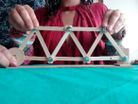
|
| Schematic (c) | Experimental (d)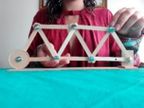
|
Schematic (e)
|
Experimental (f)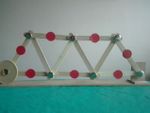
|
Schematic (g)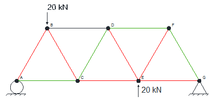
|
Experimental (h)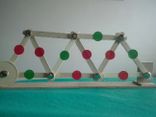
|
4. Research methodology
The research carried out is a quantitative and qualitative study, quasi-experimental, with a research design with post-test only and intact groups of correlational and cross-sectional character [42], [43]. The incorporation of different teaching methods requires a comparative analysis between a “control group” and a “study group” or “test group”, with the objective of identifying statistically significant differences between both [6], [44].
A total of 44 students attending the Statics course —part of a Civil Engineering undergraduate program— were analyzed, where two groups of the subject were used for the experiment. Both groups were taught the lecture on structural elements, support systems and trusses, the group (1) was designated as the “control group”, composed of 22 people, to which the traditional methodology was applied, while group (2), designated as “test group”, conformed by 22 people, which was instructed with a didactic methodology based on a structural game.
On the other hand, the Statics course has prerequisite the courses of: Calculus and Mechanical Physics, so that most of the students who take the course are from the same academic cohort, with the exception of some students who have attended the course twice. However, as it is a second-year course, it has been assumed that all students have the same knowledge of prerequisites, although they do not necessarily have the same skills.
In addition, it is pointed out that the type of teaching methodology that was used was not revealed to the students of each work group. This, in order not to alter the behavior of the students as a consequence of the expectation that would be generated by the fact that they would be studied, is known as the Hawthorne effect [45].
4.1. Control Group
In the control group (with traditional methodology), the lectures were taught in a conventional manner. The professor exhibited the topics by using support material developing the structural concepts. It should be noted that this methodology aims to solve problems of trusses, frames and beams from a theoretical approach, with the use of concepts of structural elements and support systems. These concepts are explained before teaching the theoretical analysis of problems, but which unfortunately lack importance to the students, whose main objective is to learn only what is needed for their future evaluation.
After the presentation of the structural concepts, the professor performs exercises contextualized with the theoretical framework, with necessary tools so that the student can solve the challenges, exercising the tools that were granted in Statics. As the students solve the exercises, they ask the professor about the resolution. This allows students to better train to solve problems related to the course. The above shows that the lectures for the control group were designed by the professor in such a way that the students received all the possible help to internalize the concepts, to obtain results comparable to the results obtained by the test group, placing the control group in the best possible scenario.
4.2. Test Group
The test group (didactic methodology), was divided into four groups of seven people each, to be able to work each group with the DICING structural kit. Collaborative learning is considered an improvement of traditional teaching methodologies, as it not only promotes the student to learn, but also helps the development of collaborative work skills, such as communication and collaboration, both considered essential for the exercise of the profession [46], [47].
The experience is developed through five stages for each activity presented, the contents to be learned are exposed and defined, and the assembly is made of a structure for which a challenge is presented, corresponding to the application of static external loads. Each group analyzes the behavior of the structure. It is finalized by concluding the solution in conjunction with each group. It should be noted that the whole session has been designed based on Kolb’s learning cycle, stating that there are different forms of learning associated with each type of person, therefore, activities aimed at a certain type of learning were proposed. Thus, when going through the entire cycle, everyone who is part of the audience will have some room for learning.
Finally, the students were presented with a series of problems for resolving trusses, based on an isostatic truss, with the aim of being able to visually analyze the types of efforts to which the structure is subjected and internalize the concepts previously seen.
5. Analysis and evaluations
5.1. Evaluation Tool
As the objective of this research was to analyze the effect of teaching structural concepts with game-based didactic methodology, the performance of the students of both groups, test group (didactic methodology) and control group (traditional methodology) was evaluated, and then results were compared. A test of categorical nominal closed questions was elaborated, an element that was built in conjunction with professors of the course, and later validated through expert judgment.
This questionnaire consists of 14 questions with alternatives, based on the theory and learning objectives of Statics. The set of questions was classified into three different categories, which illustrate the basis of the Statics theory and what an engineering student should really understand about the statics to be applied as a professional future.
The three categories of questions were: Structural elements; Support systems; Trusses.
5.2. Qualitative Evaluation
The quantitative results are limited since they only provide numerical descriptions instead of detailed accounts, and generally provide less data elaborated from human perceptions or motivations, compared to qualitative findings. On the contrary, the general purpose of qualitative research is to understand more about human perspectives and provide a detailed description of a given event or phenomenon [48]. In terms of improvements in learning, student satisfaction surveys are often used to evaluate the success of various teaching styles or methods [49], [50]. Therefore, the research sought to know the opinion of the student body on the traditional and didactic method under study. That is why a questionnaire with open questions has been applied, where the qualitative scope of the research was obtained, gathering opinions and comments from the students [51].
5.3. Statistical Analysis
The questionnaire (posttest) was completed by the students and the results compared, these were evaluated using the Wilcoxon statistical test for independent samples with a level of significance of 0.05 [52]. This non-parametric statistical hypothesis was selected because the sample size is relatively small and therefore it is not possible to assume that the data are distributed normally. Likewise, a Fisher statistical analysis was applied for the answers of both groups in each question separately, and those questions were registered where there were greater proportional differences of correct answers in favor of the group with didactic methodology [53].
6. Results and discussions
6.1. Analysis of the validity of the evaluation instrument
Content validity was obtained through expert judgment, according to the “V” evaluation criterion of Aiken, which establishes that the validity ranges for content range between 0 and 1 [54]. A checklist was applied that aims to collect evidence regarding the structural knowledge of the students of the course “Statics”. The result was a strong validity according to the average of the means of the questions and a minimum “V” of Aiken of 0.87 and a maximum of 1 for the different questions evaluated. All those that obtained a “V” coefficient below 0.87 were revised and corrected in order to improve their evaluation and be able to be applied.
The analysis of results indicated the obtaining of a coefficient of V of Aiken of 0.91 on average for all questions, which is considered acceptable, according to the literature, to confirm the validity of the content of the questionnaire.
6.2. Quantitative analysis using Wilcoxon
From the results obtained it is possible to point out that the correct answers obtained by the students of the test group (didactic methodology) have been higher than the correct answers obtained by the students of the control group (traditional methodology) in each of the categories.
The comparison of the results obtained on each group by category is shown in Table 1. Here, a statistically significant difference was observed in the total resolution of the test between both groups (p <0.0001), which indicates that the results of the test group were significantly superior to the results of the control group.
Table 1. Differences between groups 1 and 2.
| Category | Questions | Correct Percentage | Difference | p-value | |
| Group 1 | Group 2 | ||||
| A. Structural Elements | 1, 2, 3, 4 | 56.82 | 69.32 | 12.5 | 0.0394 |
| B. Support Systems | 5, 6, 7, 8, 9 | 67.27 | 85.45 | 18.18 | 0.0088 |
| C. Trusses | 10, 11, 12, 13, 14 | 40.91 | 82.73 | 41.82 | <0.0001 |
| Total | 1 – 14 | 54.87 | 79.87 | 25 | <0.0001 |
Note: Measurement made with the Wilcoxon test (Mann-Whitney) with 5% significance.
Despite placing the control group in the best possible scenario, statistically significant differences were obtained for the test group in the results, which accounts for the benefits of using a didactic methodology based on a game, given that they obtain a better understanding and practical skill.
In the analysis by categories, the percentages of correct answers by the test group were greater than in the control group in each of the categories.
Category A, B and C, in addition to showing percentage differences favorable to the test group, also presented statistically significant differences (p <0.05).
Category A was designed in such a way as to evaluate the concepts of stability, rigidity and resistance, which, although they are concepts taught in a traditional way, students do not manage to internalize. The above is reflected in the percentage differences of correct answers between the control group and the group, with a delta of 12.5% correct answers favoring the test group.
Since the statistical analysis results in a p = 0.0394 lower than the 5% required, indicating significant differences in the learning of structural elements, the significance of the didactic methodology can be corroborated.
Category B was created with the aim of internalizing support systems: internal reactions and recognition in real life. A percentage of correct responses of 18.18% higher was obtained for the control group. Also, it should be noted that in question 9, which consisted of identifying the types of support in real life, the test group got 13% more correct answers than the control group. In addition, this category obtained a significance also lower than 0.05 with a value of p = 0.0088, indicating significant differences in learning about support systems.
Finally, category C was created with the aim of understanding trusses: components and internal efforts when subjected to external forces. The percentage increase of correct answers in the test group was 41.82% and a level of significance of p <0.0001, indicating significant differences in learning about trellises. This indicates that the learning captured by the students of the test group is very favorable, this being one of the most important categories at the conceptual level, since it related the behavior of structures when subjected to external forces.
6.3. Quantitative analysis using Fisher statistics
The statistically significant differences to the responses of each group were obtained by Fisher’s exact test. Analyzing the percentage differences in each question, it was observed that 12 out of 14 questions had positive proportional differences for the test group, while the rest of the questions had negative percentage differences for the same.
Table 2 shows those questions that had statistically significant differences in favor of the test group. It is possible to appreciate that the questions in which the students of the test group answered significantly better than those of the control group, include the concepts of stability, rigidity (Category of structural elements) and in reference to the behavior of the trusses when subjected to forces external and the arrangement of its elements (Category of trusses).
Table 2. Significant differences in response between groups 1 and 2.
| Question (Content) | Correct Alternatives | Proportional | p-value | |
| Group 1 | Group 2 | Differences | ||
| P 1 (Structural Elements) | 16 | 22 | -0.272727 | 0.0105 |
| P 2 (Structural Elements) | 18 | 22 | -0.181818 | 0.0538 |
| P 10 (Trusses) | 9 | 22 | -0.590909 | 0.00001 |
| P 11 (Trusses) | 0 | 22 | -1 | 0 |
| P 12 (Trusses) | 2 | 12 | -0.454545 | 0.0014 |
Note: Measurement made with Fisher’s test. Q: Question.
The qualitative analysis of this research was carried out with the purpose of knowing the perceptions on the part of the students about the lived experience, both of the didactic methodology and of the traditional teaching methodology.
After testing the traditional and didactic methodologies, a questionnaire of four open questions related to the experience was applied, whose application would also serve to strengthen the results obtained from the quantitative analysis, being a complement of the obtained values.
The questions contained in the questionnaire were the following: (a) Summarize the content you have learned during these lectures; (b) What is your opinion about the lectures taught in this activity? (c) What is your opinion about the evaluation of this activity? (d) What is your opinion in comparison with the lectures taught in the traditional way?
In question a), the majority of the students, of both groups, were able to list the different topics studied through the traditional method and lectures with didactic methodology.
In the answers to question b), in the control group the students believe that the lectures of the professor were adequate according to both their teaching and to what was evaluated in the test. However, many of them mentioned that sometimes the lectures were a little bit monotonous. In any case, they mentioned that the lectures were adequate, because they were traditional and familiar. However, there was a small amount of comments where students who struggled to internalize more the contents taught. In contrast, in the test group, the students valued considerably that the lectures were dynamic, and that these could capture their attention at all times, apart from the fact of having visual elements that facilitate the understanding of the concepts. They used the concepts a lot: dynamism, creativity and novelty; they also indicated that they were able to understand the content in a more playful way and valued being able to apply what they learned in the practical lectures, indicating that this type of experience should be done more frequently. Finally, they emphasize that the lectures caught the attention of all the students and all had positive opinions in reference to the way in which it was exposed, since it was really understood what is being studied.
For question c), in the control group indicates that, the students lacked maturity because they did not pay full attention to concepts that were not evaluated literally in the assessments of the course. The students indicated that the evaluation was accurate and conceptual, which led them to analyze the importance of the theory at the time of learning. Regarding the test group, the students mentioned the importance of carrying out an evaluation after the session, since it implies checking if they really learned by means of the lectures taught. They also indicated that all the contents taught during the session were covered, emphasizing that the real knowledge was asked, not only related to equations.
Finally, for question d), which refers to traditional teaching, the students indicated that the lectures were good and fun but that students should be more motivated to get their attention, so that they take the real importance of the course. They mentioned that the education has advanced enough; therefore, it is necessary to implement new methodologies for teaching since all have different forms of learning.
7. Conclusions
Based on the presented objectives, an innovative didactic element called DICING was created that allows the teaching of the structural concepts through the construction of knowledge through the use of the didactic game. With this, an evaluation instrument is constructed to obtain consistent and quantifiable results thanks to its validation through expert judgment; instrument that sought to measure the knowledge of students regarding structural concepts for further quantitative and qualitative analysis.
Through the methodology implemented based on Kolb’s learning cycle — using a game that allows internalizing the structural concepts, based on the construction of knowledge, considering all types of student learning —, quantitatively and qualitatively compares both methodologies through the results obtained, after the application of the test, obtaining a favorable response from the students towards the new teaching methodology. Being able to verify significant differences in the learning of structural concepts between the students of the control group and the group test, obtaining better results in the test group, favoring the didactic methodology.
It is recommended based on the results obtained, the application of the didactic methodology as a complement to the traditional methodology, in the teaching of different engineering courses. In addition, in order to cultivate in parallel, the theoretical and the practical, it would be recommended to add a practical laboratory or workshop to the course of statics, to better understand and understand the contents, and to improve the teaching-learning process of future engineers.
References
[1] T. J. McGhee, “Engineering Education in Americas,” J. Prof. Issues Eng. Educ. Pract., vol. 117, no. 4, pp. 389–394, Oct. 1991.
[2] K. Walczak, R. Wojciechowski, and W. Cellary, “Dynamic interactive VR network services for education,” in Proceedings of the ACM Symposium on Virtual Reality Software and Technology, VRST, 2006, pp. 277–286.
[3] S. Christodoulou, “Educating Civil Engineering Professionals of Tomorrow,” J. Prof. Issues Eng. Educ. Pract., vol. 130, no. 2, pp. 90–94, Apr. 2004.
[4] A. C. Aparicio and A. M. Ruiz-Teran, “Tradition and innovation in teaching structural design in civil engineering,” J. Prof. Issues Eng. Educ. Pract., vol. 133, no. 4, pp. 340–349, 2007.
[5] R. Sacks and R. Barak, “Teaching building information modeling as an integral part of freshman year civil engineering education,” J. Prof. Issues Eng. Educ. Pract., vol. 136, no. 1, pp. 30–38, 2010.
[6] E. Forcael, C. R. Glagola, and V. González, “Incorporation of computer simulations into teaching linear scheduling techniques,” J. Prof. Issues Eng. Educ. Pract., vol. 138, no. 1, 2012.
[7] C. B. Correa, “Aprendizaje basado en problemas una experiencia novedosa en la enseñanza de la ingeniería,” Rev. Educ. en Ing., vol. 1, no. 2, pp. 45–51, Dec. 2006.
[8] M. Ebner and A. Holzinger, “Successful implementation of user-centered game based learning in higher education: An example from civil engineering,” Comput. Educ., vol. 49, no. 3, pp. 873–890, Nov. 2007.
[9] J. M. Randel, B. A. Morris, C. D. Wetzel, and B. V. Whitehill, “The Effectiveness of Games for Educational Purposes: A Review of Recent Research,” Simul. Gaming, vol. 23, no. 3, pp. 261–276, Sep. 1992.
[10] P. S. Steif and A. Dollár, “Study of Usage Patterns and Learning Gains in a Web-based Interactive Static Course,” J. Eng. Educ., vol. 98, no. 4, pp. 321–333, Oct. 2009.
[11] M. Baeten, E. Kyndt, K. Struyven, and F. Dochy, “Using student-centred learning environments to stimulate deep approaches to learning: Factors encouraging or discouraging their effectiveness,” Educational Research Review, vol. 5, no. 3. pp. 243–260, 2010.
[12] C. L. A. Dancz, K. Parrish, M. M. Bilec, and A. E. Landis, “Assessment of Students’ Mastery of Construction Management and Engineering Concepts through Board Game Design,” J. Prof. Issues Eng. Educ. Pract., vol. 143, no. 4, Oct. 2017.
[13] A. Salmisto, L. Postareff, and P. Nokelainen, “Relationships among Civil Engineering Students’ Approaches to Learning, Perceptions of the Teaching-Learning Environment, and Study Success,” J. Prof. Issues Eng. Educ. Pract., vol. 143, no. 4, Oct. 2017.
[14] M. M. Dewoolkar, L. George, N. J. Hayden, and M. Neumann, “Hands-On Undergraduate Geotechnical Engineering Modules in the Context of Effective Learning Pedagogies, ABET Outcomes, and Our Curricular Reform,” J. Prof. Issues Eng. Educ. Pract., vol. 135, no. 4, pp. 161–175, Oct. 2009.
[15] R. M. Felder and R. Brent, “The Intellectual Development of Science and Engineering Students. Part 1: Models and Challenges,” J. Eng. Educ., vol. 93, no. 4, pp. 269–277, Oct. 2004.
[16] C. L. Dym, A. M. Agogino, O. Eris, D. D. Frey, and L. J. Leifer, “Engineering Design Thinking, Teaching, and Learning,” J. Eng. Educ., vol. 94, no. 1, pp. 103–120, Jan. 2005.
[17] H. M. Thurston, “Influential Structural Engineers: A Project in a Third-year Structural Analysis Course,” J. Eng. Educ., vol. 83, no. 2, pp. 156–160, Apr. 1994.
[18] S. Sellers, J. Roberts, L. Giovanetto, … K. F.-C. for the I. of, and undefined 2007, “Reaching All Students: A Resource for Teaching in Science, Technology, Engineering and Mathematics.”
[19] K. G. Nelson, D. F. Shell, J. Husman, E. J. Fishman, and L.-K. Soh, “Motivational and Self-Regulated Learning Profiles of Students Taking a Foundational Engineering Course,” J. Eng. Educ., vol. 104, no. 1, pp. 74–100, Jan. 2015.
[20] M. de Z. Samper and J. de Z. Samper, “Fundamentos de pedagogía conceptual: una propuesta curricular para la enseñanza de las ciencias sociales para pensar,” 1986.
[21] Piaget and His School. Springer Berlin Heidelberg, 1976.
[22] E. Díaz Mosquera, “Estilos de Aprendizaje,” Eidos, no. 5, p. 5, Aug. 2012.
[23] X. Christine Wang, D. Michelle Hinn, and A. G. Kanfer, “Potential of computer-supported collaborative learning for learners with different learning styles,” J. Res. Technol. Educ., vol. 34, no. 1, pp. 75–85, 2001.
[24] D. Kolb, “Experiential learning: Experience as the source of learning and development,” 2014.
[25] J. N. Harb, S. O. Durrant, and R. E. Terry, “Use of the Kolb Learning Cycle and the 4MAT System in Engineering Education,” J. Eng. Educ., vol. 82, no. 2, pp. 70–77, Apr. 1993.
[26] A. Y. Kolb and D. A. Kolb, “Learning styles and learning spaces: Enhancing experiential learning in higher education,” Acad. Manag. Learn. Educ., vol. 4, no. 2, pp. 193–212, 2005.
[27] E. Dale, “Audiovisual Methods in Teaching. Third Edition.” Holt, Rinehart and Winston, Inc., 383 Madison Avenue, New York, N. Y. 10017 ($11.95), 1969.
[28] D. Jonassen, M. Davidson, M. Collins, J. Campbell, and B. B. Haag, “Constructivism and Computer-Mediated Communication in Distance Education,” Am. J. Distance Educ., vol. 9, no. 2, pp. 7–26, Jan. 1995.
[29] L. S. Vygotsky, Mind in society: The development of higher psychological. Harvard University Press, 1978.
[30] H. Mahn and V. John-Steiner, “Vygotsky and Sociocultural Approaches to Teaching and Learning,” in Handbook of Psychology, Second Edition, Hoboken, NJ, USA: John Wiley & Sons, Inc., 2012.
[31] B. Pagán, “Current Issue User Positive Contributions of Constructivism to Educational Design,” 2016.
[32] A. Steinemann, “Implementing sustainable development through problem-based learning: Pedagogy and practice,” J. Prof. Issues Eng. Educ. Pract., vol. 129, no. 4, pp. 216–224, Oct. 2003.
[33] D. G. Hackmann, “Constructivism and Block Scheduling: Making the Connection,” Phi Delta Kappan, vol. 85, no. 9, pp. 697–702, May 2004.
[34] J. P. Gee, “What video games have to teach us about learning and literacy,” Comput. Entertain., vol. 1, no. 1, p. 20, Oct. 2003.
[35] D. N. Perkins, Making learning whole : how seven principles of teaching can transform education. Jossey-Bass, 2009.
[36] K. Squire and H. Jenkins, Video games and learning : teaching and participatory culture in the digital age. Teachers College Press, 2011.
[37] C. A. Bodnar, D. Anastasio, J. A. Enszer, and D. D. Burkey, “Engineers at Play: Games as Teaching Tools for Undergraduate Engineering Students,” Journal of Engineering Education, vol. 105, no. 1. Wiley-Blackwell Publishing Ltd, pp. 147–200, 01-Jan-2016.
[38] “Mola Structural Kit 3: a new way to learn about structures by mola — Kickstarter.” [Online]. Available: https://www.kickstarter.com/projects/mola/mola-structural-kit-3. [Accessed: 17-Dec-2019].
[39] M. Vrontissi, “The physical model in structural studies within architecture education: paradigms of an analytic rationale?”
[40] H. A. Hadim and S. K. Esche, “Enhancing the engineering curriculum through project-based learning,” in Proceedings - Frontiers in Education Conference, 2002, vol. 2.
[41] M. Solís, A. Romero, and P. Galvín, “Teaching structural analysis through design, building, and testing,” J. Prof. Issues Eng. Educ. Pract., vol. 138, no. 3, pp. 246–253, Jul. 2012.
[42] M. Borrego, E. P. Douglas, and C. T. Amelink, “Quantitative, Qualitative, and Mixed Research Methods in Engineering Education,” J. Eng. Educ., vol. 98, no. 1, pp. 53–66, Jan. 2009.
[43] R. B. Alzina, “Metodología de la investigación educativa,” 2004.
[44] D. M. Fraser, R. Pillay, L. Tjatindi, and J. M. Case, “Enhancing the Learning of Fluid Mechanics Using Computer Simulations,” J. Eng. Educ., vol. 96, no. 4, pp. 381–388, Oct. 2007.
[45] R. McCarney, J. Warner, S. Iliffe, R. van Haselen, M. Griffin, and P. Fisher, “The Hawthorne Effect: a randomised, controlled trial,” BMC Med. Res. Methodol., vol. 7, no. 1, p. 30, Dec. 2007.
[46] B. M. Olds, B. M. Moskal, and R. L. Miller, “Assessment in Engineering Education: Evolution, Approaches and Future Collaborations,” J. Eng. Educ., vol. 94, no. 1, pp. 13–25, Jan. 2005.
[47] I. Cabrera, J. Villalon, and J. Chavez, “Blending Communities and Team-Based Learning in a Programming Course,” IEEE Trans. Educ., vol. 60, no. 4, pp. 288–295, Nov. 2017.
[48] J. A. LEYDENS, B. M. MOSKAL, and M. J. PAVELICH, “Qualitative Methods Used in the Assessment of Engineering Education,” J. Eng. Educ., vol. 93, no. 1, pp. 65–72, Jan. 2004.
[49] S. Djenic, R. Krneta, and J. Mitic, “Blended learning of programming in the internet age,” IEEE Trans. Educ., vol. 54, no. 2, pp. 247–254, May 2011.
[50] J. Wells, R. M. Barry, and A. Spence, “Using video tutorials as a carrot-and-stick approach to learning,” IEEE Trans. Educ., vol. 55, no. 4, pp. 453–458, 2012.
[51] J. L. R. Ochoa, J. L. B. Pérez, and J. A. Berrio, “Student acceptance and performance of a virtual platform for training and evaluation of Statics course,” in Proceedings - Frontiers in Education Conference, FIE, 2016, vol. 2016-November.
[52] “Infostat - Software estadístico.” [Online]. Available: https://www.infostat.com.ar/. [Accessed: 17-Dec-2019].
[53] R. Ott and M. Longnecker, “An Introduction to Statistical Methods and Data Analysis, ch. 11.7,” 2008.
[54] L. R. Aiken, “Three Coefficients for Analyzing the Reliability and Validity of Ratings,” Educ. Psychol. Meas., vol. 45, no. 1, pp. 131–142, Mar. 1985.
Document information
Published on 13/03/20
Submitted on 15/01/20
Volume 2, 2020
Licence: CC BY-NC-SA license
Share this document
Keywords
claim authorship
Are you one of the authors of this document?

